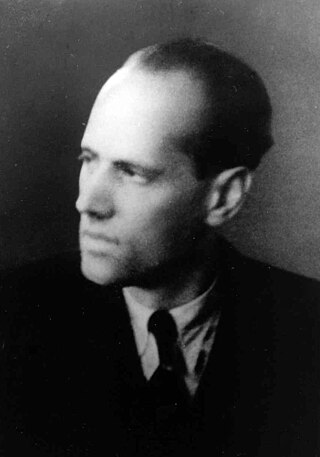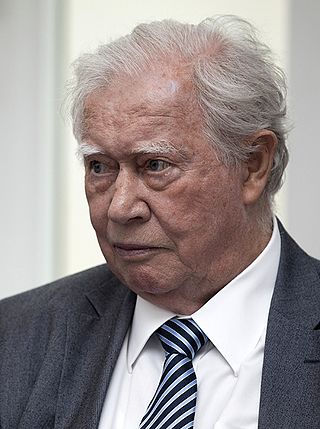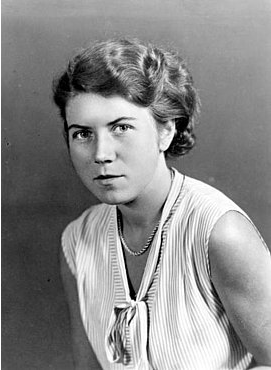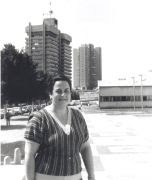
The White Rose was a non-violent, intellectual resistance group in Nazi Germany which was led by five students and one professor at the University of Munich: Willi Graf, Kurt Huber, Christoph Probst, Alexander Schmorell, Hans Scholl and Sophie Scholl. The group conducted an anonymous leaflet and graffiti campaign that called for active opposition to the Nazi regime. Their activities started in Munich on 27 June 1942; they ended with the arrest of the core group by the Gestapo on 18 February 1943. They, as well as other members and supporters of the group who carried on distributing the pamphlets, faced show trials by the Nazi People's Court ; many of them were imprisoned and executed.

Helmuth James Graf von Moltke was a German jurist who, as a draftee in the German Abwehr, acted to subvert German human-rights abuses of people in territories occupied by Germany during World War II. He was a founding member of the Kreisau Circle opposition group, whose members opposed the government of Adolf Hitler in Nazi Germany, and discussed prospects for a Germany based on moral and democratic principles after Hitler. The Nazis executed him for treason for his participation in these discussions.

Hans Mommsen was a German historian, known for his studies in German social history, for his functionalist interpretation of the Third Reich, and especially for arguing that Adolf Hitler was a weak dictator. Descended from Nobel Prize-winning historian Theodor Mommsen, he was a member of the Social Democratic Party of Germany.

Wilhelm Guddorf was a Belgian journalist, anti-Nazi and resistance fighter against the Third Reich. Guddorf was a leading member of a Berlin anti-fascist resistance group that was later called the Red Orchestra by the Abwehr. Guddorf was the editor of the Marxist-Communist Die Rote Fahne newspaper.

Maria "Mimi" Terwiel was a German resistance fighter against the Nazi regime. She was active in a group in Berlin that wrote and distributed anti-Nazi and anti-war appeals. As part of what they conceived as a broader action against a collection of anti-fascist resistance groups in Germany and occupied Europe that the Abwehr called the Red Orchestra, in September 1942 the Gestapo arrested Terwiel along with her fiancée Helmut Himpel. Among the leaflets and pamphlets they had copied and distributed for the group were the July and August 1941 sermons of Clemens August Graf von Galen which denounced the regime's Aktion T4 programme of involuntary euthanasia.

Wilhelm "Willi" Graf was a German member of the White Rose resistance group in Nazi Germany. The Catholic Church in Germany included Graf in their list of martyrs of the 20th century. In 2017, his cause for beatification was opened. He was given the title Servant of God, the first step toward possible sainthood.

Vanda Vitali is an international museum executive. She was executive director and the Chief executive of the Canadian Museums Association from 2019 through 2021. She has been director and chief executive at the Auckland Museum in Auckland, New Zealand, from 2007 through 2010, the first and only woman ever appointed to that role. She was vice president, public programs and director, content development at the Natural History Museum of Los Angeles County, in Los Angeles, California, from 2002 to 2007.
The Internationaler Sozialistischer Kampfbund or ISK was a socialist split-off from the SPD during the Weimar Republic and was active in the German Resistance against Nazism.
Sozialistischer Schutzbund was a paramilitary formation in Saar, linked to the Social Democratic Party of Saarland (SPS).
ICOFOM, the International Committee for Museology of the International Council of Museums (ICOM) was founded in 1977 at the initiative of Jan Jelínek, in order to promote research and theoretical thinking within the museum world. This committee became one of the most popular in International Council of Museums (ICOM). It addresses the study of the theoretical foundation that guides museum activities around the world or, more generally, the analysis of the different forms that museums can have. The committee includes several hundred museologists from all over the world, organizes yearly symposia and publishes, among other monographs, the annual journal ICOFOM Study Series, available online.

Waldisa Rússio Camargo Guarnieri, was a professor and museologist, most known in Brazil simply as Waldisa Rússio. She became one of the most influential personalities in the development of theoretical Museology and contributed to the constitution of the disciplinary field of Museology in Brazil. From 1957 she worked as a federal employee of the State of São Paulo in different positions and particularly in management reforms. In 1959, she graduated in the Law school of the Universidade de São Paulo – USP and started working with the management of cultural matters of the State. On the 1970s, she was involved with issues more directly related to museums.

Hanna Berger was an Austrian dancer, choreographer, teacher, director, theatre director, writer and lifelong anti-Nazi and communist. She was described as part of the free dance movement.
Alma Stephanie Wittlin, Alma S. Wittlin, was an Austrian writer. Her surname also appears as Wittlin-Frischauer.

Vinoš Sofka was a museologist. He co-founded the International Committee for Museology (ICOFOM) in 1977 and served as its chairman and vice chair.
Zbyněk Zbyslav Stránský was a Czech museologist, considered the “father of scientific museology”. Between the years 1960 and 1970, he was responsible for one of the first attempts to structure a theoretical basis for museology, when directing the Department of Museology of the Moravian Museum, in Brno. With the support of the museum director, Jan Jelínek, he founded a School of museological thinking in Brno, aiming to connect museum practice to a specific theoretical system. Zbyněk Z. Stránský, as he used to sign his texts, was the pioneer in the construction of a museology that is conceived as social science, creating an autonomous system of thought based on specific concepts.

Oda Schottmüller was an expressive dancer, mask maker and sculptor. Schottmüller was most notable as a resistance fighter against the Nazis, through her association with a Berlin-based anti-fascist resistance group that she met through the sculptor Kurt Schumacher. The group would later be named by the Gestapo as Die Rote Kapelle.

The Learning and memorial site Charlotte Taitl House in Ried im Innkreis, Austria is dedicated to the victims of National Socialism and fascism in the district of Ried im Innkreis. It is an extension of the historical exhibition of the Innviertler Volkskundehaus museum. The initiative for this project came from the ARGE Lern- und Gedenkort. The building blocks formed the publication "Nationalsozialismus im Bezirk Ried im Innkreis. Resistance and Persecution 1938-1945" by Gottfried Gansinger, which was supplemented by research from ARGE members. In May 2015, the house of Roßmarkt No. 29 was solemnly named "Charlotte Taitl House". In May 2017 the ceremonial opening of the learning and memorial place took place.
Elly Lotte Bergtel-Schleif, née Schleif, was a German librarian who was actively involved in the resistance against Nazis while a member of the Communist Party of Germany (KPD). Bergtel-Schleif became head of the Berlin Library School after the war.
Friedrich Rehmer was a German factory worker and resistance fighter against the Nazi regime. While attending an evening school in Schöneberg, Rehmer met a group of friends that included Ursula Goetze, Otto Gollnow, Hannelore Thiel, Liane Berkowitz, John Rittmeister and Werner Krauss. In December 1941, he became part of an anti-fascist network after meeting Harro Schulze-Boysen through Wolfgang Rittmeister, brother to John Rittmeister. The network was later called the Red Orchestra by the Abwehr. Rehmer was executed in 1943.

Walter Husemann was a German communist and resistance fighter against the Nazi regime. As a young man, Husemann trained an industrial toolmaker, before training as a journalist. He became interested in politics and joined the Communist Party of Germany (KPD). With the arrival of the Nazis in 1933, he became a resistance fighter and through his wife, the actor Marta Husemann, he became associated with an anti-fascist resistance group around Harro Schulze-Boysen and Arvid Harnack that was later called the Red Orchestra by the Gestapo. Along with John Sieg whom he met in the KPD and Fritz Lange, Martin Weise and Herbert Grasse he wrote and published the resistance magazine, The Internal Front Die Innere Front.












